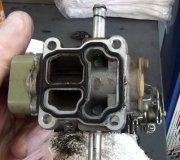Hi Yinkebo,
I have attached some test that you can do.
ENGINE REVOLUTION SIGNAL CIRCUIT TEST
With ignition switch in ON position, and engine off, check voltage between ATCU terminal No. 24 and ground. Voltage should be 0.9-4.5 volts. If voltage is not as specified, repair circuit as necessary.
FLUID TEMPERATURE SENSOR TEST
1. Check resistance between fluid temperature sensor terminals. Resistance should be 2500 ohms at 68 °F (20 °C), and 300 ohms at 176 °F (80 °C). If resistance is not as specified, replace sensor.
2. Disconnect solenoid harness connector in engine compartment. Check resistance between terminals No. 33 and 35 when transaxle is cold.
Check voltage between ATCU terminal No. 33 and ground, while warming up transaxle. If resistance and voltage is not as specified, repair circuit as necessary.
FLUID TEMPERATURE SENSOR DIAGNOSIS
Terminal Temperature Resistance --- Voltage
33 To 35 Cold (1) 2500 Ohms N/A
33 To Ground ---Warming Up (2)--- N/A 1.5-.5
(1) Cold 68 °F (20 °C).
(2) Cold 68 °F (20 °C); Hot 176 °F (80 °C).
LINE PRESSURE SOLENOID TEST
1. Check resistance between solenoid assembly connector terminal No. 4 (Red wire) and ground. Solenoid resistance should be 3.2 ohms. If resistance is not as specified, replace solenoid.
2. With ignition switch in OFF position, disconnect solenoid harness connector in engine compartment. Check resistance between solenoid harness connector terminal No. 1 and ground. Resistance should be 2.5-5 ohms. If resistance is not as specified, repair circuit as necessary.
3. Disconnect ATCU connector and check resistance between solenoid harness connector terminal No. 1 and ATCU terminal No. 2. Resistance should be 11.2-12.8. If resistance is not as specified, check resistance of dropping resistor, located under air cleaner. Resistance should be 11.2-12.8 ohms. Replace resistor as necessary.
4. Check resistance between solenoid harness connector terminal No. 1 and ATCU terminal No. 1. Resistance should be approximately zero ohms. If resistance is not as specified, repair circuit as necessary.
THROTTLE SENSOR CIRCUIT TEST
Check voltage between ATCU terminals No. 34 and 35 while depressing accelerator pedal slowly. At closed throttle, .2-.6 volt should be present. At wide open throttle, 2.9-3.9 volts should be present. Voltage rises relative to throttle valve opening.
THROTTLE VALVE SWITCH CIRCUIT
Checking Idle Switch Circuit
Check voltage between ATCU terminal No. 14 and ground while depressing accelerator slowly. When depressing accelerator pedal to wide open throttle, one volt or less should be present. When releasing accelerator pedal, 8-15 volts should be present.
Checking Full Throttle Switch Circuit
Check voltage between ATCU terminal No. 21 and ground while depressing accelerator slowly. When depressing accelerator pedal to wide open throttle, 8-15 volts should be present. When releasing accelerator pedal, one volt or less should be present.
Monday, December 1st, 2008 AT 7:10 AM



